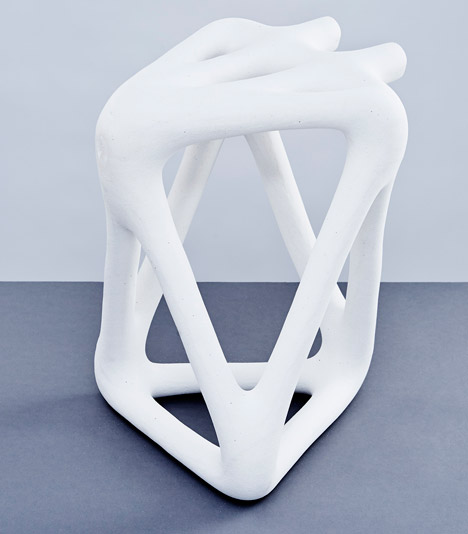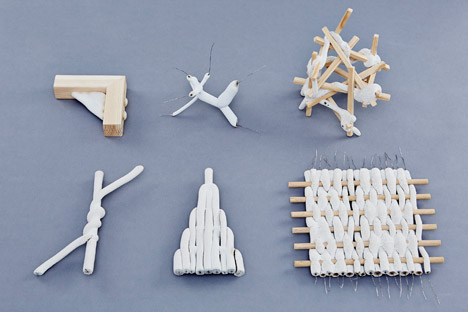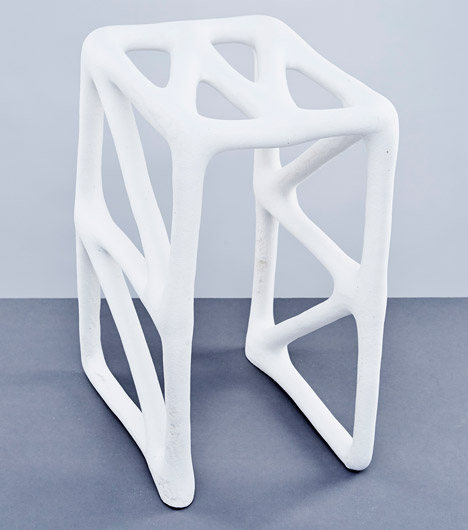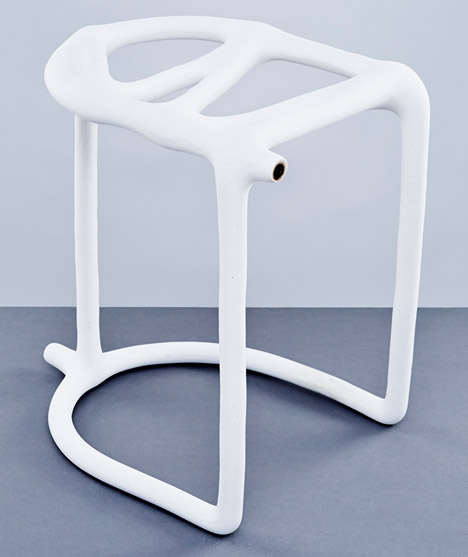Art and 3D printing often go hand in hand these days. Two graduate students at the 2015 Graduate School show of London’s Royal College of Art continue this trend, but with a bit more electricity. Fabio Hendry and Seongil Choi, who call themselves Studio Ilio, have combined electric current and nylon powder leftover from previous 3D prints in an ingeniously streamlined process for creating solid things. The resulting stools are Studio Ilio’s Hot Wire Extensions project.
In order to build their stools, Studio Ilio uses wire made from nichrome to build the stool shape that will fit within a cuboid container. Nichrome is an alloy mix of chromium, nickel, and other metals and it seems to hold up pretty well for their purposes. After creating the wire form, it is put in the cuboid container filled with leftover nylon powder from SLS 3D printing waste and a mixture of pure silica sand.
Hendry tells Dezeen, “Whenever you print an object [using Selective Laser Sintering], half of the volume of the material turns into waste and there are not viable techniques on the market to recycle this material.”
For that reason, Hot Wire Extensions seeks to turn this material into something useful.
In order to get the electricity flowing, a battery connects the wire ends sending a current of 10 to 120 volts through the metal. This heats the resistant metal to soaring temperatures up to 500 degrees Celsius. The heat attracts the powder mixture and the wires begin melting and fusing with the powder and silica sand into a solid shape. Hendry continues, “You do a sketch with the wire and then transform it into a strong structure – growing the material around the sketch. [The final shape] depends on how close the wires are together and on how you construct it.”
In order to thoroughly demonstrate the new technique for their show, Studio Ilio created 12 different shapes out of wire to make their stools, including a variety of designs from solid sections, with thin legs and woven lattices. When they ran electrical current through their designs, they found that the longer the battery was connected and running electricity, the denser the collection of the powder/silica mix became around the wires. Hendry and Choi’s stools were predominantly products of running the electricity through the wires for 20-30 minutes, but, there are a few examples of up parts up to 10 centimeters in diameter around the wires that occurred when they left the electricity running for a whole hour.
For the designers, the process and the recycled material they use are just as important as the designs themselves. They would love to see the nylon powder waste left over from SLS printing given a new life. Hendry explains, “For the project we got over a ton of waste materials just for free and there’s lots more available. It’s quite interesting to show the possibilities of how to use this waste.”
It is pretty amazing that the art world could produce not only an interesting new 3D printing-related process, but also a smart way to recycle a fraction of the tremendous waste that 3D printing produces. We are looking forward to great things from Studio Ilio.







